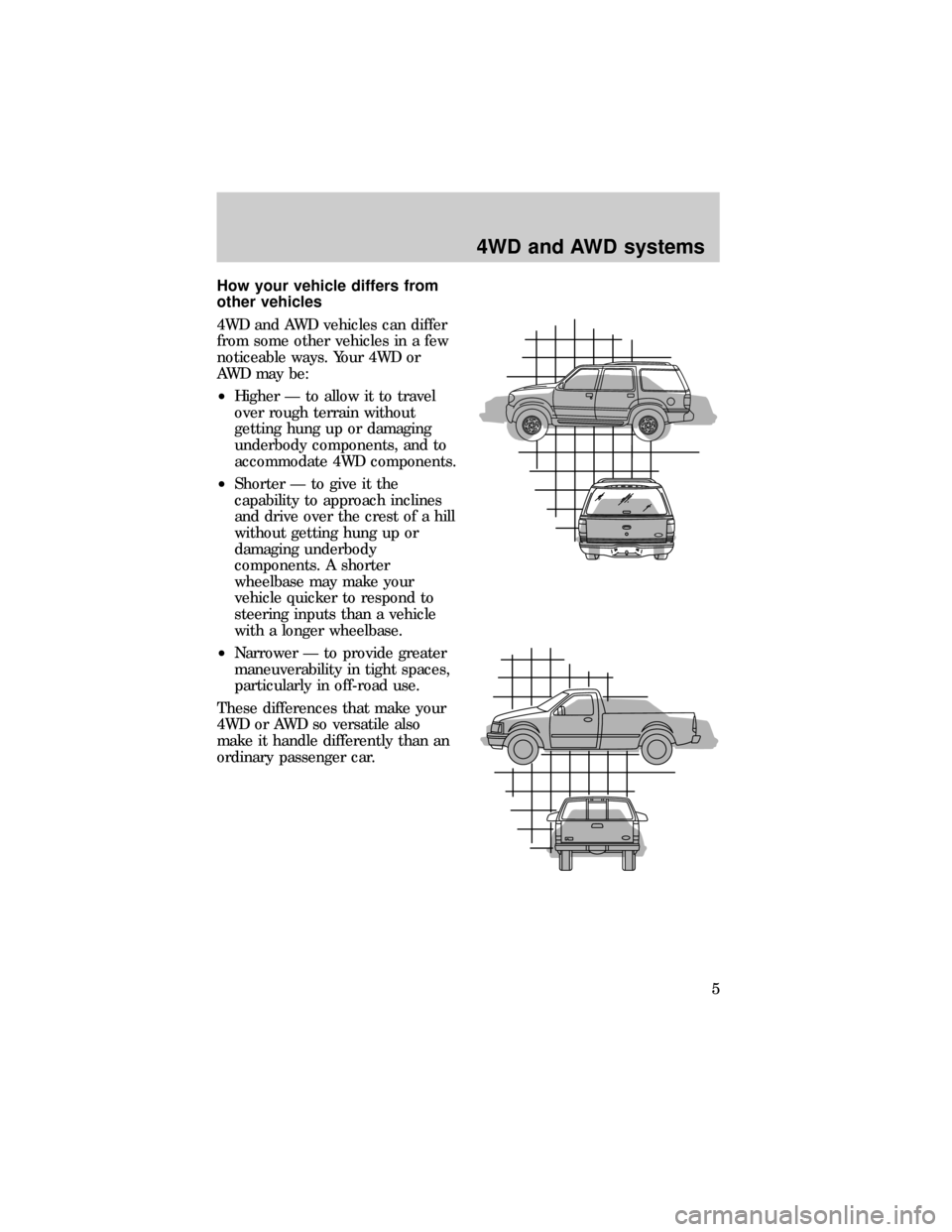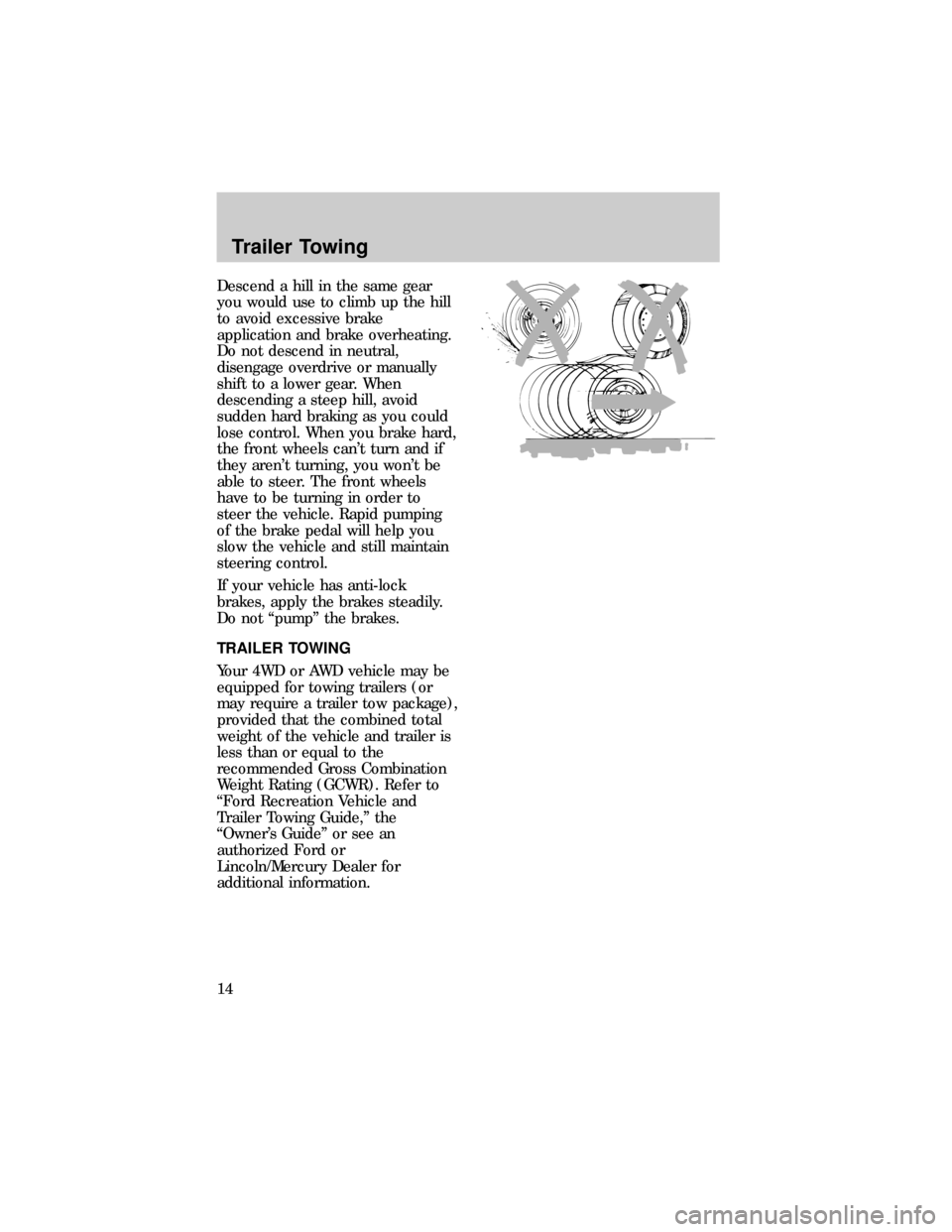steering Mercury Mountaineer 1997 Four Wheeling Supplement
[x] Cancel search | Manufacturer: MERCURY, Model Year: 1997, Model line: Mountaineer, Model: Mercury Mountaineer 1997Pages: 20, PDF Size: 0.22 MB
Page 2 of 20

INTRODUCTION
Welcome to Ford Motor Company's
world of four-wheel driving! Your
new 4WD or AWD vehicle opens
up a completely different and
challenging world of travel unlike
what you have ever experienced
with a conventional two-wheel
drive vehicle. Now, you'll be able to
travel places where roads don't.
You'll be able to travel when
weather conditions have made
roads impassible for two-wheel
drive vehicles. Most importantly,
you'll be able to travel with the
safety, comfort and dependability
of a Ford-built vehicle.
The steering and handling
characteristics of vehicles may vary
and you must learn and
understand the capabilities and
limitations of your 4WD or AWD
through experience. Take it slow
and easy until you get to know and
understand your vehicle and have
confidence in your ability to drive
it.
Your 4WD or AWD vehicle,
particularly when loaded, may
handle differently than an ordinary
passenger car. This is because your
vehicle has special design and
equipment feature for off-road
operation.
Familiarize yourself with this
vehicle's operating characteristics.
Study the ªOwner's Guideº and this
supplement for specific information
and instructions for safe driving
under various conditions.
Introduction
2
Page 5 of 20

How your vehicle differs from
other vehicles
4WD and AWD vehicles can differ
from some other vehicles in a few
noticeable ways. Your 4WD or
AWD may be:
²Higher Ð to allow it to travel
over rough terrain without
getting hung up or damaging
underbody components, and to
accommodate 4WD components.
²Shorter Ð to give it the
capability to approach inclines
and drive over the crest of a hill
without getting hung up or
damaging underbody
components. A shorter
wheelbase may make your
vehicle quicker to respond to
steering inputs than a vehicle
with a longer wheelbase.
²Narrower Ð to provide greater
maneuverability in tight spaces,
particularly in off-road use.
These differences that make your
4WD or AWD so versatile also
make it handle differently than an
ordinary passenger car.
4WD and AWD systems
5
Page 6 of 20

4WD OR AWD OPERATION ON
THE ROAD
Basic operating principles
²Do not use 4WD on dry, hard
surfaced roads (except models
equipped with Auto 4WD or
AWD). This may damage the
drivelines and axles.
²Drive slower in strong
crosswinds which can affect the
normal steering characteristics
of your vehicle.
²Be extremely careful when
driving on pavement made
slippery by loose sand, water,
gravel, snow or ice.
If your vehicle goes off the
edge of the pavement
²If your vehicle goes off the edge
of the pavement, slow down, but
avoid severe brake application,
Ease the vehicle back onto the
pavement only after reducing
your speed. Do not turn the
steering wheel too sharply while
returning to the road surface.
²It may be safer to stay on the
apron or shoulder of the road
and slow down gradually before
returning to the pavement. You
may loose control if you do not
slow down or if you turn the
steering wheel too sharply or
abruptly.
²It often may be less risky to
strike small inanimate objects,
such as highway reflectors, with
minor damage to your vehicle
4WD or AWD operation on the road
6
Page 7 of 20

rather than attempt a sudden
return to the pavement which
could cause the vehicle to slide
sideways out of control or
rollover. Remember, your safety
and the safety of others should
be your primary concern.
Emergency maneuvers
²In an unavoidable emergency
situation where a sudden sharp
turn must be made, remember
to avoid ªover-drivingº your
vehicle, i.e., turn the steering
wheel only as rapidly and as far
as required to avoid the
emergency. Excessive steering
will result in less vehicle control,
not more. Additionally, smooth
variations of the accelerator
and/or brake pedal pressure
should be utilized if changes in
vehicle speed are called for.
Avoid abrupt steering,
acceleration or braking. Use all
available road surface to return
the vehicle to a safe direction of
travel.
²In the event of an emergency
stop, avoid skidding the tires
and do not attempt any sharp
steering wheel movements.
²If the vehicle goes from one
type of surface to another (i.e.,
from concrete to gravel) there
will be a change in the way the
vehicle responds to a maneuver
(steering, acceleration or
barking). Again, avoid these
abrupt inputs.
4WD or AWD operation on the road
7
Page 8 of 20

Snow and ice
Your 4WD or AWD vehicle will
have advantages over two-wheel
drive vehicles in snow and on ice
by providing increased driving
traction. However, if you suddenly
change speed or direction you may
lose control. 4WD and AWD
vehicles can slide on slippery roads
just like any other vehicle. Should
you start to slide while driving on
snowy or icy roads, turn the
steering wheel in the direction of
the slide until you regain control.
Avoid sudden braking as well.
Although a 4WD or AWD vehicle
may accelerate better than a
two-wheel drive vehicle in snow
and ice, it won't stop any faster,
because as in other vehicles,
braking occurs at all four wheels.
Do not become overconfident as to
road conditions.
Make sure you allow sufficient
distance between you and other
vehicles for stopping. In
emergency stopping situations,
avoid locking of the wheels. Use a
ªsqueezeº technique, push on the
brake pedal with a steadily
increasing force which allows the
wheels to brake yet continue to
roll so that you may steer in the
direction you want to travel. If you
lock the wheels, release the brake
pedal and repeat the squeeze
technique. If your vehicle has
anti-lock brakes, apply the brake
steadily. Do not ªpumpº the
brakes. See your ªOwner's Guideº
for additional information on the
4WD or AWD operation on the road
8
Page 9 of 20

operation of the anti-lock brake
system.
Parking
Before leaving the driver's seat,
you should make sure that the
gearshift is engaged in P (Park)
with an automatic transmission or
either 1 (First) or R (Reverse)
with a manual transmission. Set
the parking brake fully, shut off
the ignition and remove the key.
On some 4WD vehicles, when the
transfer case is in the N (Neutral)
position, the engine and
transmission are disconnected
from the rest of the driveline.
Therefore, the vehicle is free to
roll even if the automatic
transmission is in P (Park) or the
manual transmission is in gear. Do
not leave the vehicle unattended
with the transfer case in N
(Neutral) position. Always set the
parking brake fully and turn off the
ignition when leaving the vehicle.
DRIVING OFF-ROAD WITH 4WD
OR AWD
When using 4WD or AWD,
maintain steering wheel control at
all times, especially in rough
terrain. Since sudden changes in
terrain can result in abrupt
steering wheel motion, make sure
you grip the steering wheel from
the outside. Do not grip the
spokes.
Driving off-road with 4WD or AWD
9
Page 10 of 20

Drive cautiously to avoid vehicle
damage from concealed objects
such as rocks and stumps. You
should either know the terrain or
examine maps of the area before
driving. Map out your route before
driving in the area. To maintain
steering and braking control of
your vehicle, you must have all
four wheels on the ground and
they must be rolling, not sliding or
spinning.
Sand
When driving over sand, try to
keep all four wheels on the most
solid area of the trail. Avoid
reducing the tire pressure. Instead,
shift to a lower gear and drive
steadily through the terrain. Apply
the accelerator slowly and avoid
spinning the wheels.
If you must reduce the tire
pressure for whatever reason in
sand, make sure you re-inflate the
tires as soon as possible.
Avoid excessive speed because
vehicle momentum can work
against you and cause the vehicle
to become stuck to the point that
assistance may be required from
another vehicle. Remember, you
may be able to back out the way
you came if you proceed with
caution.
Mud
Be cautious of sudden changes in
vehicle speed or direction when
you are driving in mud. Even 4WD
Driving off-road with 4WD or AWD
10
Page 14 of 20

Descend a hill in the same gear
you would use to climb up the hill
to avoid excessive brake
application and brake overheating.
Do not descend in neutral,
disengage overdrive or manually
shift to a lower gear. When
descending a steep hill, avoid
sudden hard braking as you could
lose control. When you brake hard,
the front wheels can't turn and if
they aren't turning, you won't be
able to steer. The front wheels
have to be turning in order to
steer the vehicle. Rapid pumping
of the brake pedal will help you
slow the vehicle and still maintain
steering control.
If your vehicle has anti-lock
brakes, apply the brakes steadily.
Do not ªpumpº the brakes.
TRAILER TOWING
Your 4WD or AWD vehicle may be
equipped for towing trailers (or
may require a trailer tow package),
provided that the combined total
weight of the vehicle and trailer is
less than or equal to the
recommended Gross Combination
Weight Rating (GCWR). Refer to
ªFord Recreation Vehicle and
Trailer Towing Guide,º the
ªOwner's Guideº or see an
authorized Ford or
Lincoln/Mercury Dealer for
additional information.
Trailer Towing
14
Page 15 of 20

TIRES, REPLACEMENT
REQUIREMENTS
Your 4WD or AWD vehicle is
equipped with tires designed to
provide for safe ride and handling
capability.
Do not use a size and type of tire
and wheel other than that
originally provided by Ford
because it can affect the safety
and performance of your vehicle,
which could lead to loss of vehicle
control or rollover and serious
injury. Make sure all tires and
wheels on the vehicle are of the
same size, type, tread design,
brand and load-carrying capacity. If
you have questions regarding tire
replacement, see an authorized
Ford or Lincoln/Mercury dealer.
If you nevertheless decide to equip
your 4WD or AWD for off-road use
with tires larger than what Ford
recommends, you should not use
these tires for highway driving.
If you use any tire/wheel
combination not recommended by
Ford, it may adversely affect
vehicle handling and could cause
steering, suspension, axle or
transfer case failure.
Do not useºaftermarket lift kitsº or
other suspension modifications,
whether or not they are used with
larger tires and wheels.
These ªaftermarket lift kitsº could
adversely affect the vehicle's
handling characteristics, which
could lead to loss of vehicle
Tires, replacement requirements
15
Page 17 of 20

Inspect the tire side walls for cuts,
bruises and other damage. If
internal damage to the tire is
suspected, have the tire
demounted and inspected in case
it needs to be repaired or replaced.
MAINTENANCE AND
MODIFICATIONS
The suspension and steering
systems on your vehicle have been
designed and tested to provide
both reasonably safe, predictable
performance whether loaded or
empty and durable load carrying
capability. For this reason, Ford
strongly recommends that you do
not make modifications such as
adding or removing parts (such as
lift kits or stabilizer bars) or by
using replacement parts not
equivalent to the original factory
equipment.
Any modifications to a vehicle that
raise the center of gravity can
make it more likely the vehicle will
roll over as a result of a loss of
control. Ford recommends that
caution be used with any vehicle
equipped with a high load or
device (such as ladder racks or
pickup box cover).
Failure to maintain your vehicle
properly may void the warranty,
increase your repair cost, reduce
vehicle performance and
operational capabilities and
adversely affect driver and
passenger safety. Frequent
inspection of vehicle chassis
Maintenance and modifications
17